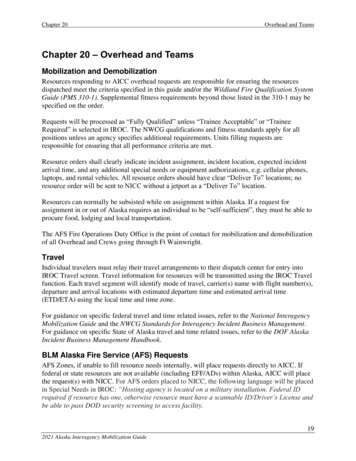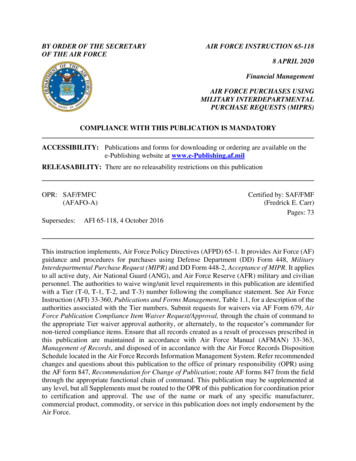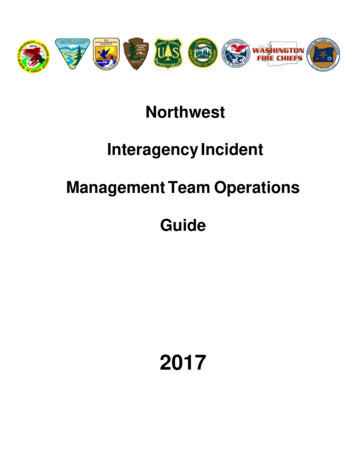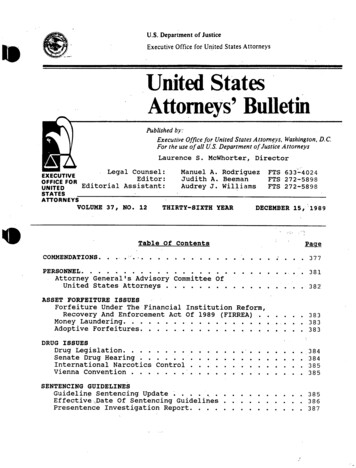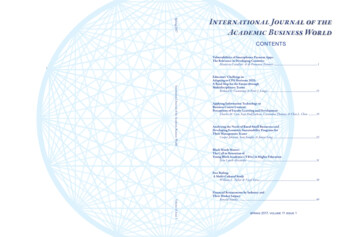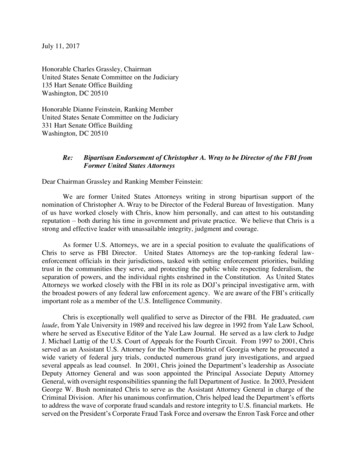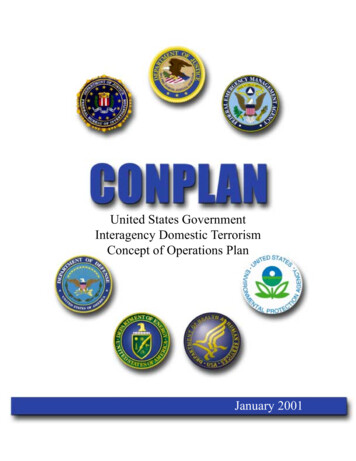
Transcription
United States GovernmentInteragency Domestic TerrorismConcept of Operations PlanJanuary 2001
UNITED STATES GOVERNMENTINTERAGENCY DOMESTIC TERRORISMCONCEPT OF OPERATIONS PLAN
TABLE OF CONTENTSPage NumberTable of ContentsiForewordiiiLetter of AgreementivSignatories to the PlanviList of FiguresFigure 1:Figure 2:Figure 3:Figure 4:Figure 5:1719212326I.II.Incident Command System / Unified CommandFBI Command PostCoordinating RelationshipsJoint Operations CenterOn-Scene CoordinationIntroduction and BackgroundA.IntroductionB.PurposeC.ScopeD.Primary Federal AgenciesE.Primary Agency Responsibilities1.Department of Justice (DOJ)/Federal Bureau of Investigation (FBI)2.Federal Emergency Management Agency (FEMA)3.Department of Defense (DOD)4.Department of Energy (DOE)5.Environmental Protection Agency (EPA)6.Department of Health and Human Services (HHS)112233PoliciesA.AuthoritiesB.Other Plans and DirectivesC.Federal Agency AuthoritiesD.Federal Response to a Terrorism Incident1.Crisis Management2.Consequence ManagementE.Lead Federal Agency DesignationF.Requests For Federal AssistanceG.FundingH.Deployment/Employment Priorities66667778899i344455
I.J.Planning Assumptions and ConsiderationsTraining and es between WMD Incidents and Other IncidentsC.Threat Levels1.Level #4 - Minimal Threat2.Level #3 - Potential Threat3.Level #2 - Credible Threat4.Level #1 - WMD IncidentD.Lead Federal Agency Responsibilities111111121313131314IV.Concept of OperationsA.MissionB.Command and Control1.Consequence Management2.Crisis ManagementC.Unification of Federal, State and Local Response1.Introduction2.National Level Coordination3.Field Level Coordination4.On-Scene Coordination15151515182020202224V.Phasing of the Federal ResponseA.Notification1.The Role of the FBI2.The Role of FEMAB.Activation and Deployment1.The Role of the FBI2.The Role of FEMAC.Response OperationsD.Response DeactivationE.Recovery27272728282929303030Appendix A AcronymsA-1Appendix B DefinitionsB-1ii
FOREWORDPublication of the United States Government Interagency Domestic TerrorismConcept of Operations Plan (CONPLAN) represents a concerted effort by a number ofFederal departments and agencies to work together to achieve a common goal. TheCONPLAN was developed through the efforts of six primary departments and agencieswith responsibilities as identified in Presidential Decision Directive/NSC-39 (PDD-39).This plan has been developed consistent with relevant PDDs, Federal law, the AttorneyGeneral’s Critical Incident Response Plan, the PDD-39 Domestic Guidelines, and theFederal Response Plan and its Terrorism Incident Annex. The FBI has worked with thesedepartments and agencies to provide a forum to participate in planning and exerciseactivities in order to develop, maintain, and enhance the Federal response capability.To ensure the policy in PDD-39 and PDD-62 is implemented in a coordinatedmanner, the CONPLAN is designed to provide overall guidance to Federal, State andlocal agencies concerning how the Federal government would respond to a potential oractual terrorist threat or incident that occurs in the United States, particularly oneinvolving Weapons of Mass Destruction (WMD). The CONPLAN outlines an organizedand unified capability for a timely, coordinated response by Federal agencies to a terroristthreat or act. It establishes conceptual guidance for assessing and monitoring adeveloping threat, notifying appropriate Federal, State, and local agencies of the nature ofthe threat, and deploying the requisite advisory and technical resources to assist the LeadFederal Agency (LFA) in facilitating interdepartmental coordination of crisis andconsequence management activities.Actions will continue to refine and identify the mission, capabilities, andresources of other supporting departments and agencies; and the actions each agency ordepartment must perform during each phase of the response, to include crisismanagement and consequence management actions that are necessary for chemical,biological, nuclear/radiological, and conventional materials or devices.Inquiries concerning this CONPLAN should be addressed to the appropriate LeadAgency under this plan: Federal Bureau of Investigation, Counterterrorism Division, DomesticTerrorism/Counterterrorism Planning Section, for Crisis Management, or Federal Emergency Management Agency, Response and RecoveryDirectorate, Operations and Planning Division, for Consequence Management.iii
LETTER OF AGREEMENTThe United States Government Interagency Domestic Terrorism Concept ofOperations Plan, hereafter referred to as the CONPLAN, is designed to provide overallguidance to Federal, State and local agencies concerning how the Federal governmentwould respond to a potential or actual terrorist threat or incident that occurs in the UnitedStates, particularly one involving WMD.The following departments and agencies agree to support the overall concept ofoperations of the CONPLAN in order to carry out their assigned responsibilities underPDD-39 and PDD-62. The departments and agencies also agree to implement nationaland regional planning efforts and exercise activities in order to maintain the overallFederal response capability. Specifically: The Attorney General is responsible for ensuring the development andimplementation of policies directed at preventing terrorist attacksdomestically, and will undertake the criminal prosecution of these acts ofterrorism that violate U.S. law. The Department of Justice has charged theFederal Bureau of Investigation with execution of its LFA responsibilities forthe management of a Federal response to terrorist incidents. As the leadagency for crisis management, the FBI will implement a Federal crisismanagement response. As LFA, the FBI will designate a Federal on-scenecommander (OSC) to ensure appropriate coordination of the overall UnitedStates Government response with Federal, State and local authorities untilsuch time as the Attorney General transfers the LFA role to the FederalEmergency Management Agency (FEMA). As the lead agency for consequence management, FEMA will implement theFederal Response Plan (FRP) to manage and coordinate the Federalconsequence management response in support of State and local authorities. The Department of Defense will provide military assistance to the LFA and/orthe CONPLAN primary agencies during all aspects of a terrorist incident uponrequest by the appropriate authority and approval by the Secretary of Defense. The Department of Energy will provide scientific-technical personnel andequipment in support of the LFA during all aspects of a nuclear/radiologicalWMD terrorist incident. The Environmental Protection Agency will provide technical personnel andsupporting equipment to the LFA during all aspects of a WMD terroristincident.iv
The Department of Health and Human Services is the primary agency to planand to prepare for a national response to medical emergencies arising from theterrorist use of WMD. HHS provides technical personnel and supportingequipment to the LFA during all aspects of a terrorist incident.v
SIGNATORIES TO THE UNITED STATES GOVERNMENT INTERAGENCYDOMESTIC TERRORISM CONCEPT OF OPERATIONS PLANSecretaryDepartment of DefenseSecretaryDepartment of EnergySecretaryDepartment of Health and Human ServicesAdministratorEnvironmental Protection AgencyDirectorFederal Emergency Management AgencyDirectorFederal Bureau of InvestigationAttorney GeneralDepartment of Justicevi
I.INTRODUCTION AND BACKGROUNDA.IntroductionThe ability of the United States Government to prevent, deter, defeat andrespond decisively to terrorist attacks against our citizens, whether these attacksoccur domestically, in international waters or airspace, or on foreign soil, is one ofthe most challenging priorities facing our nation today. The United States regardsall such terrorism as a potential threat to national security, as well as a violentcriminal act, and will apply all appropriate means to combat this danger. In doingso, the United States vigorously pursues efforts to deter and preempt these crimesand to apprehend and prosecute directly, or assist other governments inprosecuting, individuals who perpetrate or plan such terrorist attacks.In 1995, President Clinton signed Presidential Decision Directive 39(PDD-39), the United States Policy on Counterterrorism. This PresidentialDirective built upon previous directives for combating terrorism and furtherelaborated a strategy and an interagency coordination mechanism andmanagement structure to be undertaken by the Federal government to combat bothdomestic and international terrorism in all its forms. This authority includesimplementing measures to reduce our vulnerabilities, deterring terrorism througha clear public position, responding rapidly and effectively to threats or actualterrorist acts, and giving the highest priority to developing sufficient capabilitiesto combat and manage the consequences of terrorist incidents involving weaponsof mass destruction (WMD).To ensure this policy is implemented in a coordinated manner, the Conceptof Operations Plan, hereafter referred to as the CONPLAN, is designed to provideoverall guidance to Federal, State and local agencies concerning how the Federalgovernment would respond to a potential or actual terrorist threat or incident thatoccurs in the United States, particularly one involving WMD. The CONPLANoutlines an organized and unified capability for a timely, coordinated response byFederal agencies to a terrorist threat or act. It establishes conceptual guidance forassessing and monitoring a developing threat, notifying appropriate Federal, State,and local agencies of the nature of the threat, and deploying the requisite advisoryand technical resources to assist the Lead Federal Agency (LFA) in facilitatinginteragency/interdepartmental coordination of a crisis and consequencemanagement response. Lastly, it defines the relationships between structuresunder which the Federal government will marshal crisis and consequencemanagement resources to respond to a threatened or actual terrorist incident.1
B.PurposeThe purpose of this plan is to facilitate an effective Federal, response to allthreats or acts of terrorism within the United States that are determined to be ofsufficient magnitude to warrant implementation of this plan and the associatedpolicy guidelines established in PDD-39 and PDD-62. To accomplish this, theCONPLAN: Establishes a structure for a systematic, coordinated and effectivenational response to threats or acts of terrorism in the United States; Defines procedures for the use of Federal resources to augment andsupport local and State governments; and Encompasses both crisis and consequence managementresponsibilities, and articulates the coordination relationships betweenthese missions.C.ScopeThe CONPLAN is a strategic document that: Applies to all threats or acts of terrorism within the United States; Provides planning guidance and outlines operational concepts for theFederal crisis and consequence management response to a threatenedor actual terrorist incident within the United States; Serves as the foundation for further development of detailed national,regional, State, and local operations plans and procedures; Includes guidelines for notification, coordination and leadership ofresponse activities, supporting operations, and coordination ofemergency public information across all levels of government; Acknowledges the unique nature of each incident, the capabilities ofthe local jurisdiction, and the activities necessary to prevent or mitigatea specific threat or incident; and Illustrates ways in which Federal, State and local agencies can mosteffectively unify and synchronize their response actions.2
D.Primary Federal AgenciesThe response to a terrorist threat or incident within the U.S. will entail ahighly coordinated, multi-agency local, State, and Federal response. In support ofthis mission, the following primary Federal agencies will provide the core Federalresponse: Department of Justice (DOJ) / Federal Bureau of Investigation (FBI) *Federal Emergency Management Agency (FEMA) **Department of Defense (DOD)Department of Energy (DOE)Environmental Protection Agency (EPA)Department of Health and Human Services (DHHS)* Lead Agency for Crisis Management** Lead Agency for Consequence ManagementAlthough not formally designated under the CONPLAN, other Federaldepartments and agencies may have authorities, resources, capabilities, orexpertise required to support response operations. Agencies may be requested toparticipate in Federal planning and response operations, and may be asked todesignate staff to function as liaison officers and provide other support to theLFA.E.Primary Agency Responsibilities1.Department of Justice (DOJ)/Federal Bureau of Investigation (FBI)The Attorney General is responsible for ensuring the developmentand implementation of policies directed at preventing terrorist attacksdomestically, and will undertake the criminal prosecution of these acts ofterrorism that violate U.S. law. DOJ has charged the FBI with executionof its LFA responsibilities for the management of a Federal response toterrorist threats or incidents that take place within U.S. territory or thoseoccurring in international waters that do not involve the flag vessel of aforeign country. As the lead agency for crisis management, the FBI willimplement a Federal crisis management response. As LFA, the FBI willdesignate a Federal on-scene commander to ensure appropriatecoordination of the overall United States Government response withFederal, State and local authorities until such time as the Attorney Generaltransfers the overall LFA role to FEMA. The FBI, with appropriateapproval, will form and coordinate the deployment of a DomesticEmergency Support Team (DEST) with other agencies, when appropriate,and seek appropriate Federal support based on the nature of the situation.3
2.Federal Emergency Management Agency (FEMA)As the lead agency for consequence management, FEMA willmanage and coordinate any Federal consequence management response insupport of State and local governments in accordance with its statutoryauthorities. Additionally, FEMA will designate appropriate liaison andadvisory personnel for the FBI’s Strategic Information and OperationsCenter (SIOC) and deployment with the DEST, the Joint OperationsCenter (JOC), and the Joint Information Center (JIC).3.Department of Defense (DOD)DOD serves as a support agency to the FBI for crisis managementfunctions, including technical operations, and a support agency to FEMAfor consequence management. In accordance with DOD Directives3025.15 and 2000.12 and the Chairman Joint Chiefs of Staff CONPLAN0300-97, and upon approval by the Secretary of Defense, DOD willprovide assistance to the LFA and/or the CONPLAN primary agencies, asappropriate, during all aspects of a terrorist incident, including both crisisand consequence management. DOD assistance includes threatassessment; DEST participation and transportation; technical advice;operational support; tactical support; support for civil disturbances;custody, transportation and disposal of a WMD device; and othercapabilities including mitigation of the consequences of a release.DOD has many unique capabilities for dealing with a WMD andcombating terrorism, such as the US Army Medical Research Institute forInfectious Diseases, Technical Escort Unit, and US Marine CorpsChemical Biological Incident Response Force. These and other DODassets may be used in responding to a terrorist incident if requested by theLFA and approved by the Secretary of Defense.4.Department of Energy (DOE)DOE serves as a support agency to the FBI for technical operationsand a support agency to FEMA for consequence management. DOEprovides scientific-technical personnel and equipment in support of theLFA during all aspects of a nuclear/radiological WMD terrorist incident.DOE assistance can support both crisis and consequence managementactivities with capabilities such as threat assessment, DEST deployment,LFA advisory requirements, technical advice, forecasted modelingpredictions, and operational support to include direct support of tacticaloperations. Deployable DOE scientific technical assistance and supportincludes capabilities such as search operations; access operations;diagnostic and device assessment; radiological assessment and monitoring;4
identification of material; development of Federal protective actionrecommendations; provision of information on the radiological response;render safe operations; hazards assessment; containment, relocation andstorage of special nuclear material evidence; post-incident clean-up; andon-site management and radiological assessment to the public, the WhiteHouse, and members of Congress and foreign governments. All DOEsupport to a Federal response will be coordinated through a Senior EnergyOfficial.5.Environmental Protection Agency (EPA)EPA serves as a support agency to the FBI for technical operationsand a support agency to FEMA for consequence management. EPAprovides technical personnel and supporting equipment to the LFA duringall aspects of a WMD terrorist incident. EPA assistance may includethreat assessment, DEST and regional emergency response teamdeployment, LFA advisory requirements, technical advice and operationalsupport for chemical, biological, and radiological releases. EPA assistanceand advice includes threat assessment, consultation, agent identification,hazard detection and reduction, environmental monitoring; sample andforensic evidence collection/analysis; identification of contaminants;feasibility assessment and clean-up; and on-site safety, protection,prevention, decontamination, and restoration activities. EPA and theUnited States Coast Guard (USCG) share responsibilities for response tooil discharges into navigable waters and releases of hazardous substances,pollutants, and contaminants into the environment under the National Oiland Hazardous Substances Pollution Contingency Plan (NCP). EPAprovides the predesignated Federal On-Scene Coordinator for inland areasand the USCG for coastal areas to coordinate containment, removal, anddisposal efforts and resources during an oil, hazardous substance, or WMDincident.6.Department of Health and Human Services (HHS)HHS serves as a support agency to the FBI for technical operationsand a support agency to FEMA for consequence management. HHSprovides technical personnel and supporting equipment to the LFA duringall aspects of a terrorist incident. HHS can also provide regulatory followup when an incident involves a product regulated by the Food and DrugAdministration. HHS assistance supports threat assessment, DESTdeployment, epidemiological investigation, LFA advisory requirements,and technical advice. Technical assistance to the FBI may includeidentification of agents, sample collection and analysis, on-site safety andprotection activities, and medical management planning. Operationalsupport to FEMA may include mass immunization, mass prophylaxis,5
mass fatality management, pharmaceutical support operations (NationalPharmaceutical Stockpile), contingency medical records, patient tracking,and patient evacuation and definitive medical care provided through theNational Disaster Medical System.II.POLICIESA.AuthoritiesThe following authorities are the basis for the development of theCONPLAN: Presidential Decision Directive 39, including the Domestic Guidelines Presidential Decision Directive 62 Robert T. Stafford Disaster Relief and Emergency Assistance ActB.Other Plans and Directives Federal Response Plan, including the Terrorism Incident AnnexFederal Radiological Emergency Response PlanNational Oil and Hazardous Substances Pollution Contingency PlanHHS Health and Medical Services Support Plan for the FederalResponse to Assets of Chemical/Biological Terrorism Chairman of the Joint Chiefs of Staff CONPLAN 0300/0400 DODD 3025.15 Military Assistance to Civil Authorities Other Department of Defense DirectivesC.Federal Agency AuthoritiesThe CONPLAN does not supersede existing plans or authorities that weredeveloped for response to incidents under department and agency statutoryauthorities. Rather, it is intended to be a coordinating plan between crisis andconsequence management to provide an effective Federal response to terrorism.The CONPLAN is a Federal signatory plan among the six principal departmentsand agencies named in PDD-39. It may be updated and amended, as necessary, byconsensus among these agencies.6
D.Federal Response to a Terrorism IncidentThe Federal response to a terrorist threat or incident provides a tailored,time-phased deployment of specialized Federal assets. The response is executedunder two broad responsibilities:1.Crisis ManagementCrisis management is predominantly a law enforcement functionand includes measures to identify, acquire, and plan the use of resourcesneeded to anticipate, prevent, and/or resolve a threat or act of terrorism. Ina terrorist incident, a crisis management response may include traditionallaw enforcement missions, such as intelligence, surveillance, tacticaloperations, negotiations, forensics, and investigations, as well as technicalsupport missions, such as agent identification, search, render safeprocedures, transfer and disposal, and limited decontamination. Inaddition to the traditional law enforcement missions, crisis managementalso includes assurance of public health and safety.The laws of the United States assign primary authority to theFederal government to prevent and respond to acts of terrorism orpotential acts of terrorism. Based on the situation, a Federal crisismanagement response may be supported by technical operations, and byconsequence management activities, which should operate concurrently.2.Consequence ManagementConsequence management is predominantly an emergencymanagement function and includes measures to protect public health andsafety, restore essential government services, and provide emergency reliefto governments, businesses, and individuals affected by the consequencesof terrorism. In an actual or potential terrorist incident, a consequencemanagement response will be managed by FEMA using structures andresources of the Federal Response Plan (FRP). These efforts will includesupport missions as described in other Federal operations plans, such aspredictive modeling, protective action recommendations, and massdecontamination.The laws of the United States assign primary authority to the Stateand local governments to respond to the consequences of terrorism; theFederal government provides assistance, as required.7
E.Lead Federal Agency DesignationAs mandated by the authorities referenced above, the operational responseto a terrorist threat will employ a coordinated, interagency process organizedthrough a LFA concept. PDD-39 reaffirms and elaborates on the U.S.Government’s policy on counterterrorism and expands the roles, responsibilitiesand management structure for combating terrorism. LFA responsibility isassigned to the Department of Justice, and is delegated to the FBI, for threats oracts of terrorism that take place in the United States or in international waters thatdo not involve the flag vessel of a foreign country. Within this role, the FBIFederal on-scene commander (OSC) will function as the on-scene manager for theU.S. Government. All Federal agencies and departments, as needed, will supportthe Federal OSC. Threats or acts of terrorism that take place outside of the UnitedStates or its trust territories, or in international waters and involve the flag vesselof a foreign country are outside the scope of the CONPLAN.In addition, these authorities reaffirm that FEMA is the lead agency forconsequence management within U.S. territory. FEMA retains authority andresponsibility to act as the lead agency for consequence management throughoutthe Federal response. FEMA will use the FRP structure to coordinate all Federalassistance to State and local governments for consequence management. Toensure that there is one overall LFA, PDD-39 directs FEMA to support theDepartment of Justice (as delegated to the FBI) until the Attorney Generaltransfers the LFA role to FEMA. At such time, the responsibility to function asthe on-scene manager for the U.S. Government transfers from the FBI FederalOSC to the Federal Coordinating Officer (FCO).F.Requests For Federal AssistanceRequests for Federal assistance by State and local governments, as well asthose from owners and operators of critical infrastructure facilities, arecoordinated with the lead agency (crisis or consequence) responsible under U.S.law for that function. In response to a terrorist threat or incident, multiple orcompeting requests will be managed based on priorities and objectives establishedby the JOC Command Group.State and local governments will submit requests for Federal crisismanagement assistance through the FBI. State and local governments will submitrequests for Federal consequence management assistance through standardchannels under the Federal Response Plan. FEMA liaisons assigned to the DESTor JOC coordinate requests with the LFA to ensure consequence managementplans and actions are consistent with overall priorities. All other requests forconsequence management assistance submitted outside normal channels to theDEST or JOC will be forwarded to the Regional Operations Center (ROC)Director or the Federal Coordinating Officer (FCO) for action.8
G.FundingAs mandated by PDD-39, Federal agencies directed to participate incounterterrorist operations or the resolution of terrorist incidents bear the costs oftheir own participation, unless otherwise directed by the President. Thisresponsibility is subject to specific statutory authorization to provide supportwithout reimbursement. In the absence of such specific authority, the EconomyAct applies, and reimbursement cannot be waived.H.Deployment/Employment PrioritiesThe multi-agency JOC Command Group, managed by the Federal OSC,ensures that conflicts are resolved, overall incident objectives are established, andstrategies are selected for the use of critical resources. These strategies will bebased on the following priorities:1.Preserving life or minimizing risk to health. This constitutes thefirst priority of operations.2.Preventing a threatened act from being carried out or an existingterrorist act from being expanded or aggravated.3.Locating, accessing, rendering safe, controlling, containing,recovering, and disposing of a WMD that has not yet functioned.4.Rescuing, decontaminating, transporting and treating victims.Preventing secondary casualties as a result of contamination or collateralthreats.5.Releasing emergency public information that ensures adequate andaccurate communications with the public from all involved responseagencies.I.6.Restoring essential services and mitigating suffering.7.Apprehending and successfully prosecuting perpetrators.8.Conducting site restoration.Planning Assumptions and Considerations1.The CONPLAN assumes that no single private or governmentagency at the local, State, or Federal level possesses the authority and theexpertise to act unilaterally on the difficult issues that may arise in9
response to threats or acts of terrorism, particularly if nuclear, radiological,biological, or chemical materials are involved.2.The CONPLAN is based on the premise that a terrorist incidentmay occur at any time of day with little or no warning, may involve singleor multiple geographic areas, and result in mass casualties.3.The CONPLAN also assumes an act of terrorism, particularly anact directed against a large population center within the United Statesinvolving nuclear, radiological, biological, or chemical materials, willhave major consequences that can overwhelm the capabilities of manylocal and State governments to respond and may seriously challengeexisting Federal response capabilities, as well.4.Federal participating agencies may need to respond on short noticeto provide effective and timely assistance to State and local governments.5.Federal departments and agencies would be expected to provide aninitial response when warranted under their own authorities and funding.Decisions to mobilize Federal assets will be coordinated with the FBI andFEMA.6.In the case of a biological WMD attack, the effect may betemporally and geographically dispersed, with no determined or defined“incident site.” Response operations may be conducted over a multijurisdictional, multi-State region.7.A biological WMD attack employing a contagious agent mayrequire quarantine by State and local health officials to contain the diseaseoutbreak.8.Local, State, and Federal responders will define workingperimeters that overlap. Perimeters may be used by responders to controlaccess to an affected area, to assign operational sectors among respondingorganizations, and to assess potential effects on the population and theenvironment. Control of these perimeters and response actions may bemanaged by different authorities, which will impede the effectiveness ofthe overall response if adequate coordination is not established.9.If appropriate personal protective equipment and capabilities arenot available and the area is contaminated with WMD materials, it ispossible that response actions into a contaminated area may be delayeduntil the material has dissipated to a level that is safe for emergencyresponse personnel to operate.10
J.Training and ExercisesFederal agencies, in conjunction with State and local governments, willperiodically exercise their roles and responsibilities designated under theCONPLAN. Federal agencies should coordinate their exercises with the ExerciseSubgroup of the Interagency Working Group on Counterterror
terrorism that violate U.S. law. The Department of Justice has charged the Federal Bureau of Investigation with execution of its LFA responsibilities for the management of a Federal response to terrorist incidents. As the lead agency for crisis management, the FBI will implement a Federal crisis management response.




